| [1] 周永梅,黄明,燕玲,等.骨髓间充质干细胞在染矽尘大鼠体内示踪研究[J].中国职业医学,2015,42(2):128-135.
[2] 黄明,周永梅,宋向荣,等.骨髓间充质干细胞对染矽尘大鼠肺损伤修复作用研究[J].中国职业医学, 2014,41(4):361-366.
[3] 黄明,周永梅,李斌,等.经气管移植骨髓间充质干细胞在染矽尘大鼠体内的归巢[J].中国组织工程研究,2015,19(23):3711-3715.
[4] 中国疾病预防控制中心职业卫生与中毒控制所. 关于实验性尘肺研究问题的访谈[J].中华劳动卫生职业病杂志,2010,28(1): 1-2.
[5] De Miguel MP, Fuentes-Julián S, Blázquez-Martínez A, et al. Immunosuppressive properties of mesenchymal stem cells: advances and applications. Curr Mol Med. 2012;12(5): 574-591.
[6] Tsai HL, Chang JW, Yang HW, et al. Amelioration of paraquat-induced pulmonary injury by mesenchymal stem cells. Cell Transplant. 2013;22(9):1667-1681.
[7] Shen Q, Chen B, Xiao Z, et al. Paracrine factors from mesenchymal stem cells attenuate epithelial injury and lung fibrosis. Mol Med Rep. 2015;11(4):2831-2837.
[8] Berry SE. Concise review: mesoangioblast and mesenchymal stem cell therapy for muscular dystrophy: progress, challenges, and future directions. Stem Cells Transl Med. 2015;4(1):91-98.
[9] Hashemi SM, Ghods S, Kolodgie FD, et al. A placebo controlled, dose-ranging, safety study of allogenic mesenchymal stem cells injected by endomyocardial delivery after an acute myocardial infarction. Eur Heart J. 2008;29(2): 251-259.
[10] Karp JM, Leng Teo GS. Mesenchymal stem cell homing: the devil is in the details. Cell Stem Cell. 2009;4(3):206-216. |







